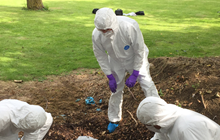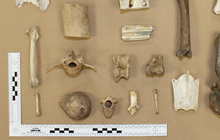Available courses
Our experts have designed the following courses for those working in Law Enforcement to continue their professional development. From Senior Investigating Officers to Crime Scene Investigators and Crime Scene Managers, our courses improve understanding in a range of forensic disciplines.

Blood Pattern Analysis Awareness for Clothing
1 Day | Certificate of Attendance
This one-day introduction to Blood Pattern Analysis (BPA) on clothing covers a broad idea of what to expect when an incident involves violence and a bleeding injury and how blood can be deposited onto clothing as well as the types of stain or pattern which can be observed.

Blood Pattern Analysis Awareness for Scenes
1 Day | Certificate of Attendance
This one-day introduction to blood pattern analysis covers a broad idea of what to expect at a scene involving the presence of blood, including the types of stains and patterns which can be obtained.

1/2 Day | Certificate of Attendance
A half-day awareness course is designed to give an overview of Cell Site Analysis to anyone in the criminal justice system who conducts investigations.

Chemical Enhancement and Acid Reagents
Bespoke Course | Certificate of Attendance
This chemical enhancement and acid reagents course is designed to provide an understanding of the theory and application of acid reagents at scenes. The course is a bespoke course, which means that police forces can tailor the modules of the course to their requirements.

2 Day | Certificate of Attendance
This two-day awareness course is ideal for any expert and professional witness who may have to give evidence in court.

Crime Scene Investigation (CSI) Level 1
6 Weeks | Approved by Chartered Society of Forensic Sciences for CPD Certification.
This six-week CSI Level 1 course is designed to provide foundation learning and skills development for CSIs appointed into VCSI/Level 1 positions. It is appropriate for new appointees with no prior experience in the role.

Crime Scene Investigation (CSI) Level 2
3 Weeks | Certificate of Attendance
This three-week Crime Scene Investigation (CSI) Level 2 course is designed to build upon the formal training gained by CSIs during VCSI or Level 1 initial training course, and to utilise the professional experience they have gained in related roles.

2 Weeks | Certificate of Attendance
This two-week course will provide an introduction to the role of the Crime Scene Manager (CSM) and the structure of major incident investigation.

Digital Media Investigator (DMI)
Certificate of Attendance
This online training course explores the capabilities of a DMI and how they can support other departments in all lines of investigation.

Disaster Victim Identification (DVI)
1 Day | Approved by Chartered Society of Forensic Sciences for CPD Certification.
This one-day Disaster Victim Identification (DVI) provides an overview of how Forensic Anthropology and Archaeology can be applied to DVI operations, particularly where victims’ remains are disrupted, burnt, and / or commingled.

Human Skeletal Anatomy and Comparative Anatomy
1 Day | Approved by Chartered Society of Forensic Sciences for CPD Certification.
This course provides an overview of the techniques used by Forensic Anthropologists in Human Skeletal Anatomy and Comparative Anatomy and the role they play in an investigation.

Recognising, Excavating & Recording Clandestine Graves
1 Day | Approved by Chartered Society of Forensic Sciences for CPD Certification.
This course provides an understanding of the role of Forensic Archaeologists & Anthropologists at a crime scene and techniques used in the excavation of clandestine graves as part of an investigation.

Surface Dispersal of Human Remains
1 Day | Approved by Chartered Society of Forensic Sciences for CPD Certification.
This course provides an understanding of the role of a Forensic Archaeologist and Anthropologist in an investigation, including the techniques used in the recovery of dispersed surface remains.

5 Days | Certificate of Attendance
This five-day course has been designed by Forensic Fire Scene experts to provide people who have a Crime Scene Investigation (CSI) background with the relevant knowledge and practical skills required to manage and undertake a fire scene investigation.

Footwear Mark, Tyre Mark and Tool Mark Evidence Awareness
1 Day | Certificate of Attendance
This one-day awareness course on footwear mark, tyre mark and tool mark evidence will provide an overview of marks which can be found a scene of crime.

Open-Source & Social Media Intelligence (OSINT & SOCMINT)
2 Days | Certificate of Attendance
This two-day awareness course instructs legal professionals, investigators, journalists, HR & vetting operatives on how to commence an OSINT investigation with some hints and tips along the way.

4 Days | Certificate of Attendance
This course is designed for anybody involved in the search, recovery and identification of human remains, including Crime Scene Investigators, Crime Scene Managers or Senior Investigating Officers.

Sexual Assault Case Investigation Awareness
1 Day | Certificate of Attendance
This one-day course in sexual assault case investigations provides an understanding into how forensic biology can assist in such cases and how it can be used at the scene and in the laboratory.

Firearms: Shooting Incident Reconstruction
5 Days | Certificate of Attendance
This five-day Shooting Incident Reconstruction course provides hands-on training in forensic ballistics, trajectory analysis, and crime scene investigation. It equips professionals with essential skills for reconstructing shooting incidents accurately and effectively.